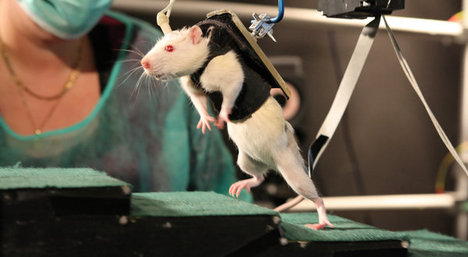 “After several weeks of neurorehabilitation, previously paralyzed rats initiated a walking gait and soon began sprinting, climbing stairs and avoiding obstacles.” Source of caption and photo: online version of the NYT article quoted and cited below.
“After several weeks of neurorehabilitation, previously paralyzed rats initiated a walking gait and soon began sprinting, climbing stairs and avoiding obstacles.” Source of caption and photo: online version of the NYT article quoted and cited below.
(p. A13) Rats with a spinal cord injury that left their hind legs completely paralyzed learned to walk again on their own after an intensive training course that included electrical stimulation of the brain and the spine, scientists reported on Thursday.
. . .
The report, published online on Thursday in the journal Science, provides a striking demonstration of what until recently few scientists thought possible: complete rehabilitation after a disabling blow to the spinal cord. After weeks of training, many of the rats could walk as well as before the injury, and some could run.
. . .
The rats then began a daily regimen. Outfitted with tiny vests, held upright on their back legs but left to bear their full weight, the rats tried to move toward a piece of cheese that beckoned nearby. They lurched forward like furry paratroopers, unsteady on their feet after a hard landing.
The scientists provided stimulation in three places: electrically, in the motor area of the brain and in the spinal cord below the injury, and chemically, infusing the wound area with drugs thought to promote growth.
And growth is what they got. After two to three weeks of 30-minute daily sessions, the rats began to take their first voluntary steps. After six weeks, all of the rats could walk on their own, and some could run and climb stairs.
. . .
In effect, . . . , the training forces the brain to recruit what is left of the neural system to get the job done. Neurons sprout like seedlings on a Chia Pet when they are seeking new connections, and the scientists found increases of 300 percent and more in projections in the brain stem and around the injury — evidence that the nervous system was remapping its connections.
For the full story, see:
BENEDICT CAREY. “In Rat Experiment, New Hope for Spine Injuries.” The New York Times (Fri., June 1, 2012): A13.
(Note: online version of the story is dated May 31, 2012.)

